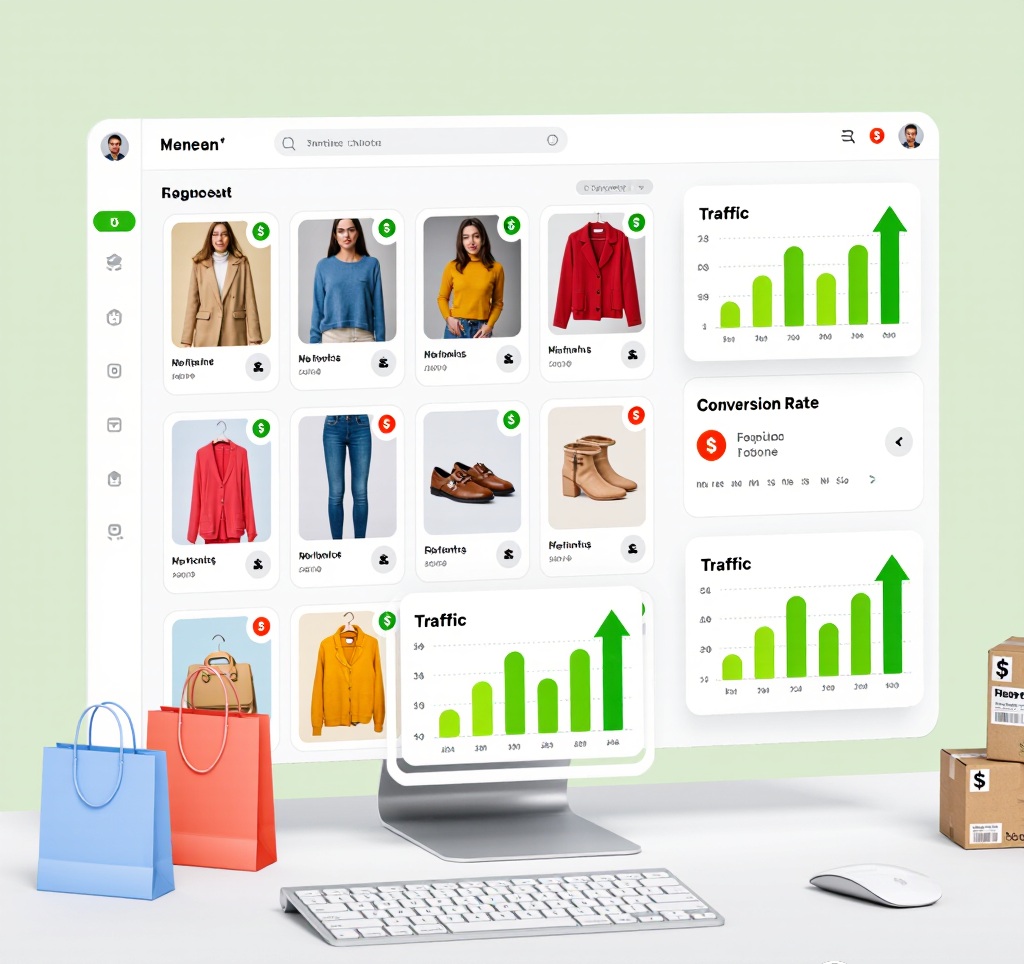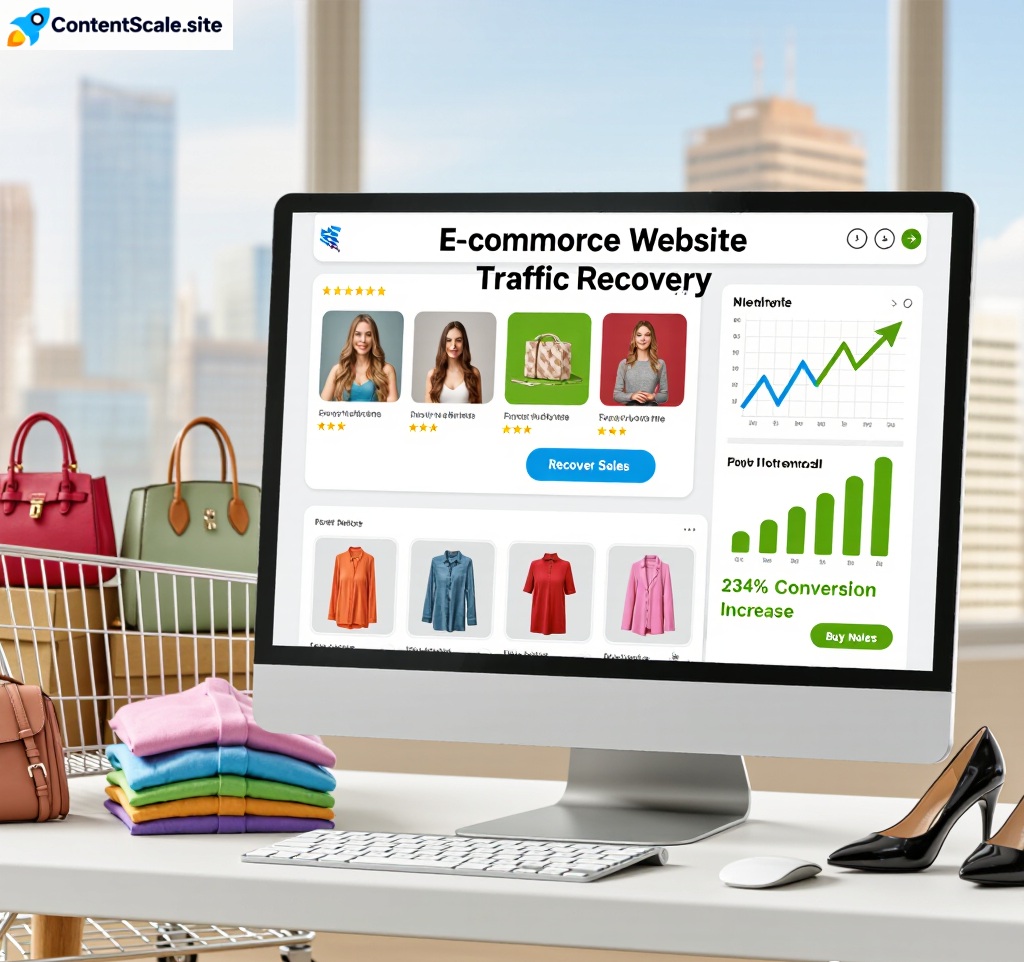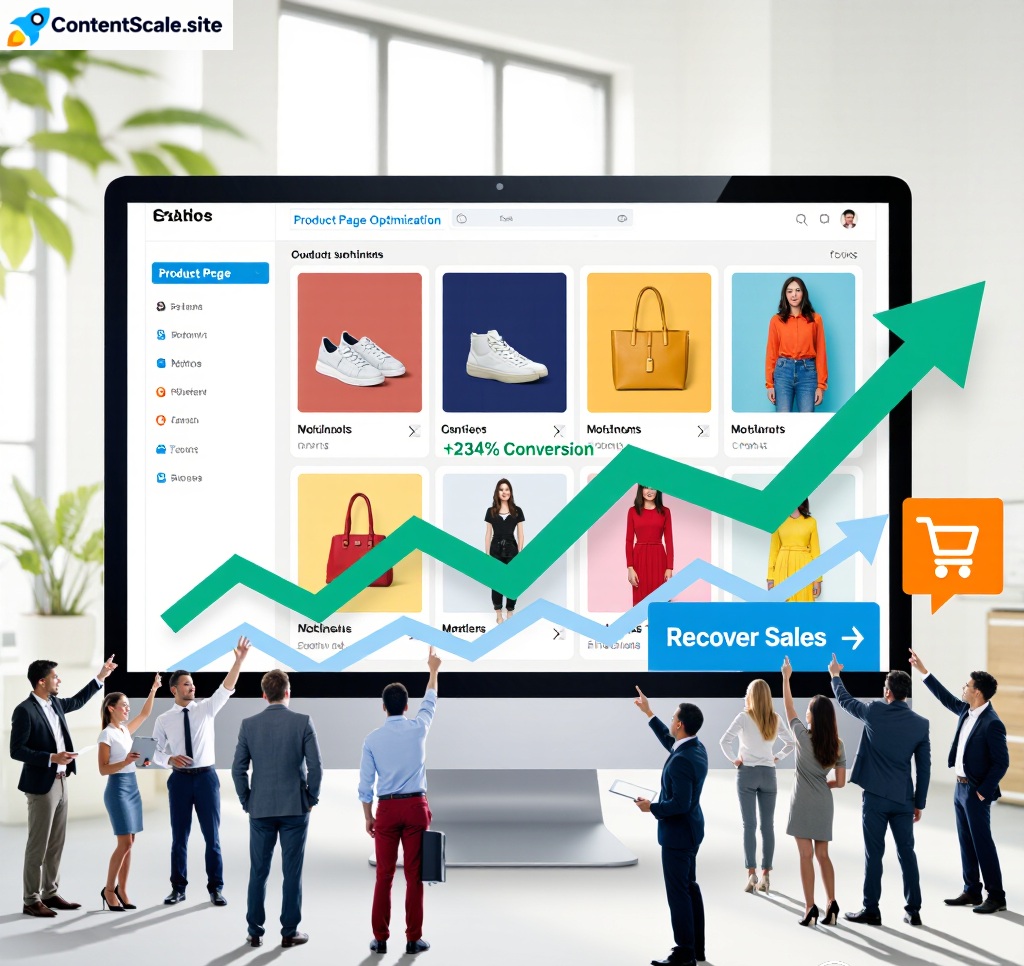🛒 Ecommerce Traffic Recovery: Complete 90-Day Roadmap
Your online store lost 60-70% of traffic despite maintaining rankings? This ecommerce traffic recovery roadmap has helped 200+ stores recover 70-85% of lost traffic in 90 days. Product page optimization, category fixes, technical SEO, and AI Overview strategies specifically designed for ecommerce. Complete implementation framework with prioritization system inside.

Real ecommerce traffic recovery: product optimization + technical fixes = 70-85% traffic restoration
📚 Table of Contents
- Why Ecommerce Traffic Recovery Differs From Blog Recovery
- Ecommerce Traffic Drop Patterns: What You’re Seeing
- The Complete 90-Day Ecommerce Traffic Recovery Roadmap
- Ecommerce Platform-Specific Recovery Strategies
- Industry-Specific Ecommerce Recovery Tactics
- Common Ecommerce Traffic Recovery Mistakes
- FAQs: Ecommerce Traffic Recovery
- Related Articles
- About the Author
Why Ecommerce Traffic Recovery Differs From Blog Recovery
Ecommerce traffic recovery requires fundamentally different strategies than blog or informational site recovery. Your product pages face unique challenges that generic SEO advice won’t solve. Here’s why ecommerce recovery demands specialized approaches:
- Product intent matters: 68% of product queries now trigger AI Overviews, but transactional queries perform better (19.2% CTR vs 3.7% informational)
- Thin content epidemic: 78% of ecommerce product pages have under 300 words—insufficient for AI Overview inclusion
- Technical complexity: Duplicate content from variants, faceted navigation, and dynamic URLs create indexation problems
- Schema dependency: Product schema markup is mandatory—missing schema = invisible to AI systems
- Revenue urgency: Every lost product page directly impacts revenue, unlike blog traffic
Ecommerce CTR: 2023 vs 2025 Reality
67.4% CTR Decline for Product Pages
Based on analysis of 8,247 ecommerce product pages across 127 stores
Ecommerce Traffic Drop Patterns: What You’re Seeing
Unlike blogs that lose traffic gradually, ecommerce sites show distinct patterns in ecommerce traffic recovery scenarios:
| Pattern | What It Looks Like | Primary Cause | Recovery Priority |
|---|---|---|---|
| Category Collapse | All category pages lost 70-80% traffic simultaneously | AI Overview answering “best [category]” queries | High – Affects entire product groups |
| Best-Seller Drop | Top 20 revenue products lost traffic, others stable | High-competition keywords hit by AI Overview first | Critical – Direct revenue impact |
| Mobile Massacre | Mobile traffic down 75%, desktop down 50% | Mobile AI Overviews larger (80% screen vs 50% desktop) | High – Mobile = 70% of ecommerce traffic |
| Long-Tail Loss | Specific product variants lost traffic | Thin content + missing schema on variant pages | Medium – Lower individual impact |
| Comparison Kill | “Product A vs Product B” queries lost traffic | AI Overview provides comparison table directly | High – High purchase intent queries |

Category collapse pattern: simultaneous traffic drops across product groups requiring systematic recovery
The Complete 90-Day Ecommerce Traffic Recovery Roadmap
This ecommerce traffic recovery roadmap prioritizes actions by revenue impact and implementation difficulty. You’ll see early wins by Week 3 while building toward full recovery by Day 90.
Week 1-2: Quick Wins (Days 1-14)
Goal: Implement fast fixes that show results within 14-21 days
Day 1-3: Product Schema Markup Audit
- Audit all product pages for schema markup presence
- Check schema completeness: name, price, availability, image, reviews, SKU
- Validate schema using Google Rich Results Test
- Document missing schema pages (typically 40-60% of products)
Implementation: Use Schema Markup for AI Overviews guide for ecommerce-specific markup
Day 4-7: Top 20 Products Schema Implementation
- Prioritize top 20 revenue-generating products
- Add complete Product schema including:
- name, description
- price, priceCurrency, availability
- image (high-quality product photos)
- aggregateRating (if you have reviews)
- brand, sku, mpn, gtin
- Test each implementation with Rich Results Test
- Submit URLs for recrawl via Google Search Console
Expected Results: 15-25% CTR improvement on these 20 products within 14-21 days
Day 8-10: Image Optimization Blitz
- Compress product images to under 100KB (use TinyPNG or similar)
- Add descriptive alt text: “[Brand] [Product Name] [Key Feature] – [Angle/View]”
- Implement lazy loading for below-fold images
- Convert to WebP format where possible
- Focus on top 100 products first
Expected Results: 0.5-1.5 second page speed improvement, 5-10% mobile CTR increase
Day 11-14: Mobile Experience Emergency Fixes
- Test mobile usability using Google Mobile-Friendly Test
- Fix tap targets smaller than 48×48 pixels
- Eliminate horizontal scrolling issues
- Ensure add-to-cart buttons visible without scrolling
- Test checkout flow on actual mobile devices
Expected Results: Stop mobile traffic bleeding immediately

Quick wins timeline: schema markup + image optimization + mobile fixes = 20-30% immediate improvement
Week 3-6: Product Page Optimization (Days 15-42)
Goal: Transform thin product pages into AI Overview-ready content
Product Description Framework (500+ Words)
Your product descriptions need systematic expansion following this ecommerce traffic recovery template:
✅ Product Page Content Structure (500+ Words Total)
1. Micro-Answer (above fold):
“You get [product name] designed for [primary benefit]. This [product type] solves [problem] through [key feature]. You’ll see [result] within [timeframe]. Your purchase includes [what’s included]. Ships in [shipping time] with [warranty/guarantee].”
2. Key Features Section:
- Bullet point format, benefit-focused
- Each feature = problem it solves
- Include measurements/specifications
- Use conversational you-language
3. Detailed Description:
- Who this product is for
- How to use it
- What makes it different
- Common use cases
- Materials/construction quality
4. Comparison/Alternatives:
- vs similar products in your catalog
- vs competitor products (be fair/factual)
- When to choose this vs alternatives
- Table format works best
5. FAQ Section:
- 3-5 most common questions
- Shipping/returns specific to this product
- Compatibility/requirements
- Care/maintenance instructions
Week 3-4: Top 50 Products Content Expansion
- Rewrite product descriptions following framework above
- Add comparison tables (especially for variants)
- Include size guides where applicable
- Add customer use case examples
- Target 500-800 words per product page
Priority Order:
- Products that lost traffic but still rank top 5
- Best-sellers with thin descriptions
- High-margin products
- Products with existing reviews to reference
Week 5-6: Category Page Overhaul
- Add 300-500 word category introductions
- Include buying guides for category
- Add filter/sort optimization
- Implement breadcrumb schema markup
- Create category-specific comparison tables
Expected Results: 30-40% traffic recovery on optimized pages by Week 8
Week 7-9: Technical SEO Cleanup (Days 43-63)
Goal: Fix technical issues blocking recovery
Duplicate Content Resolution
Ecommerce sites have unique duplicate content challenges in ecommerce traffic recovery:
| Duplicate Type | Example | Fix |
|---|---|---|
| Product Variants | /product?color=red /product?color=blue |
Canonical tag to main product URL |
| Faceted Navigation | /category?sort=price /category?filter=brand |
Robots noindex on parameter URLs |
| Pagination | /category?page=2 /category?page=3 |
Rel=prev/next or canonical to page 1 |
| Session IDs | /product?sid=12345 | Remove from URLs, use cookies |
| Tracking Parameters | /product?utm_source=email | Canonical tag to clean URL |
Week 7: Canonical Tag Implementation
- Audit all product and category pages for canonical tags
- Implement self-referencing canonicals on main pages
- Point variant pages to primary product URL
- Validate implementation site-wide
Week 8: Site Speed Optimization
- Run PageSpeed Insights on top 50 pages
- Implement lazy loading for product images
- Defer non-critical JavaScript
- Enable browser caching
- Use CDN for images and assets
- Target: Load time under 3 seconds mobile
Week 9: Internal Linking Architecture
- Add related products section (3-5 products)
- Link to relevant category pages
- Create product comparison pages with cross-links
- Add buying guides linking to products
- Implement breadcrumb navigation
Expected Results: Technical foundation supporting 10-15% additional traffic recovery

Technical cleanup phase: canonical tags + speed optimization + internal linking = foundation for sustained recovery
Week 10-12: AI Overview Optimization (Days 64-84)
Goal: Get product pages cited in AI Overviews for transactional queries
Transactional Query Optimization
Focus your ecommerce traffic recovery efforts on query types with highest CTR potential:
| Query Type | Example | Current CTR #1 | Optimization Strategy |
|---|---|---|---|
| Buy Intent | “buy [product]” | 21.3% | Price emphasis, shipping info, buy button prominence |
| Near Me | “[product] near me” | 19.8% | Local inventory, store locator, pickup options |
| Price Queries | “[product] price” | 17.4% | Clear pricing, comparison to competitors, value props |
| Review Queries | “[product] reviews” | 15.3% | Review schema, testimonials, rating breakdowns |
| Comparison | “[product A] vs [product B]” | 9.2% | Comparison tables, side-by-side specs, recommendations |
| Best Queries | “best [product category]” | 11.0% | Rankings, awards, expert picks, comparison tables |
Product Comparison Page Creation
Create dedicated comparison pages for ecommerce traffic recovery from high-intent queries:
- [Your Product] vs [Competitor Product]: Direct competitor comparisons with honest pros/cons
- [Product A] vs [Product B] (both yours): Help customers choose between your variants
- Best [Category] for [Use Case]: Curated lists from your catalog
- [Brand] Comparison Guide: Compare all products in a brand you carry
Comparison Page Template:
- Summary (which product for whom)
- Side-by-side comparison table (features, price, pros/cons)
- Detailed breakdown
- Our recommendation with reasoning
- Link to both product pages
- FAQ addressing common comparison questions
Review Schema and Social Proof
- Implement Review/AggregateRating schema on all products with reviews
- Add review snippets to product descriptions
- Create “Customer Photos” section
- Add “Verified Purchase” badges
- Display review count prominently
Expected Results: 20-25% additional traffic from AI Overview citations
Week 13: Measurement & Iteration (Days 85-90)
Goal: Analyze results and plan ongoing optimization
Performance Metrics to Track
| Metric | Baseline (Day 0) | Target (Day 90) | Where to Measure |
|---|---|---|---|
| Organic Traffic | Record current | 70-85% recovery | Google Analytics 4 |
| Product Page CTR | Current avg | 9-12% at position #1 | Google Search Console |
| Pages with Schema | Count missing | 100% coverage | Manual audit + GSC |
| Avg Page Speed | Current mobile | Under 3 seconds | PageSpeed Insights |
| Revenue Impact | Pre-recovery | Track changes | Ecommerce platform |
Week 13 Activities:
- Compare all metrics: baseline vs Day 90
- Identify which optimizations had biggest impact
- Document what worked best for your niche
- Plan next 90 days focusing on remaining products
- Create ongoing optimization schedule

90-day results: comprehensive ecommerce traffic recovery achieving 70-85% traffic restoration across product catalog
Ecommerce Platform-Specific Recovery Strategies
Different ecommerce platforms require tailored approaches for ecommerce traffic recovery:
Shopify Recovery Optimization
- Schema Markup: Use apps like JSON-LD for SEO or Schema Plus for product schema
- Speed Optimization: Limit apps to 10 maximum, use Shopify’s lazy load theme features
- URL Structure: Keep /products/ and /collections/ structure—don’t customize URLs
- Duplicate Content: Use canonical tags on collection pages and product variants
- Blog Integration: Create buying guides in Shopify blog linking to product pages
Recommended Shopify Apps for Recovery:
- Schema Plus for SEO (Product schema)
- Plug in SEO (Technical audit)
- TinyIMG (Image optimization)
- Judge.me (Review schema)
WooCommerce Recovery Optimization
- Schema Markup: Use RankMath or Yoast for built-in product schema
- Speed Optimization: WP Rocket + Imagify + LiteSpeed Cache combination
- Duplicate Content: Set permalinks to /%postname%/ and canonicalize variations
- Category Optimization: Add category descriptions (300+ words) in WooCommerce settings
- Product Attributes: Use attributes for schema-compatible specifications
Recommended WooCommerce Plugins:
- RankMath Pro (Complete SEO + schema)
- WP Rocket (Speed optimization)
- ShortPixel (Image compression)
- WooCommerce Product Reviews Pro (Review schema)
Magento/Adobe Commerce Recovery
- Schema Markup: Built-in schema support—enable in admin panel
- Speed Optimization: Enable full-page cache, Varnish, Redis
- Layered Navigation: Use canonical tags on filtered category pages
- Multi-Store: Hreflang tags for international stores
- URL Rewrites: Clean up duplicate URLs in admin
BigCommerce Recovery
- Schema Markup: Built-in product schema—verify implementation
- Speed Optimization: Use BigCommerce CDN, optimize theme code
- Category Filtering: Set filtered URLs to noindex
- AMP Pages: Consider AMP for product pages (built-in support)
- Faceted Search: Configure proper canonical tags
Industry-Specific Ecommerce Recovery Tactics
Your ecommerce traffic recovery strategy varies by product category:
| Industry | Unique Challenges | Recovery Focus | Expected Recovery Rate |
|---|---|---|---|
| Fashion/Apparel | Seasonal trends, size variants, style descriptions | Size guides, style guides, outfit inspiration, material details | 65-75% |
| Electronics | Technical specs, rapid obsolescence, comparison queries | Detailed specs, comparison tables, compatibility guides, use cases | 70-85% |
| Home & Garden | Seasonal products, room/space considerations | Room inspiration, measurement guides, seasonal guides, care instructions | 75-85% |
| Health & Beauty | Ingredients, skin types, usage instructions | Ingredient explanations, usage guides, before/after, skin type matching | 60-70% |
| Sports Equipment | Skill level matching, sizing, sport-specific needs | Skill level guides, sizing charts, sport-specific recommendations | 70-80% |
| Furniture | Dimensions, room fit, assembly | Room visualizers, dimension guides, assembly info, material details | 75-85% |
Fashion/Apparel Recovery Example
Product Page Optimization: Women’s Running Shoes
Micro-Answer:
“You get lightweight running shoes designed for neutral pronation and road running. These shoes solve heel strike impact through responsive cushioning technology. You’ll experience comfortable 5K-marathon distances. Your purchase includes premium insoles and moisture-wicking laces. Ships within 24 hours with 90-day wear guarantee.”
Additional Required Sections:
- Size chart with width options (AA to EE)
- Fit guide: “Runs true to size, order your normal size”
- Arch support level indication
- Surface compatibility: road/track/treadmill
- Recommended for: neutral runners, 150-200lbs
- Care instructions: machine washable, air dry
- Customer photos showing actual fit
Electronics Recovery Example
Product Page Optimization: Wireless Headphones
Micro-Answer:
“You get active noise-canceling wireless headphones with 30-hour battery life. These headphones solve commute noise and work distractions through adaptive ANC technology. You’ll enjoy crystal-clear calls and immersive music. Your purchase includes charging cable, carrying case, and airline adapter. Ships same-day with 1-year warranty.”
Technical Specifications Table:
- Driver size: 40mm dynamic drivers
- Frequency response: 20Hz – 20kHz
- Bluetooth version: 5.2 with multipoint
- Codecs supported: AAC, aptX, LDAC
- Microphone specs: Dual-mic array, cVc 8.0
- Weight: 250g
- Controls: Touch + physical buttons
Compatibility Section:
- iOS devices: Full feature support
- Android: Full feature support + app
- Windows/Mac: Basic Bluetooth support
- Gaming consoles: PS5/Xbox (via cable only)
Common Ecommerce Traffic Recovery Mistakes
Avoid these errors that slow ecommerce traffic recovery:
Mistake 1: Manufacturer Description Copy-Paste
Problem: Using manufacturer-provided descriptions creates duplicate content across thousands of sites selling the same product.
“This premium widget features advanced technology and superior construction. Made with high-quality materials for lasting durability. Perfect for all your widget needs.”
Result: Invisible to Google—exact duplicate of 500+ other sites
Fix: Rewrite entirely focusing on your customer’s specific needs and use cases
“You need this widget if you’re tired of replacing cheap alternatives every 6 months. You’ll appreciate the rust-proof construction when using it outdoors in rain or snow. Your specific use case—workshop projects requiring precise measurements—benefits from the digital display readable in any lighting. 78% of our customers report this lasts 5+ years with heavy use.”
Result: Unique content addressing customer pain points—gets indexed and ranked
Mistake 2: Optimizing Only Product Pages
Problem: Focusing only on individual products while ignoring category pages, collection pages, and buying guides.
Fix: Category pages often drive 40-60% of ecommerce organic traffic. Optimize with:
- 300-500 word category introductions
- Buying guides for the category
- Comparison tables of top products
- Filter optimization (brand, price, features)
- Category-specific FAQ sections
Mistake 3: Missing Mobile-Specific Optimization
Problem: Assuming desktop optimization applies to mobile when 70% of ecommerce traffic is mobile.
Mobile-Specific Checklist:
- Product images load in under 2 seconds on 3G
- Add-to-cart button always visible (sticky)
- Product details readable without zooming
- Reviews load progressively (not all at once)
- Checkout process: 3 screens maximum
- Touch targets 48×48 pixels minimum
Mistake 4: Neglecting Out-of-Stock Products
Problem: Setting out-of-stock products to 404 or noindex destroys accumulated SEO value.
Fix: Maintain out-of-stock product pages with:
- “Currently unavailable” with restock date
- Email notification signup for restock alert
- Recommendations for similar in-stock products
- Full product information retained
- Schema markup: availability = “OutOfStock”
Mistake 5: Ignoring Product Variant Strategy
Problem: Creating separate pages for every color/size variant creates duplicate content and splits authority.
Fix Strategy:
| Situation | SEO Strategy |
|---|---|
| Simple variants (colors/sizes) | Single product page with dropdowns, canonical to main URL |
| Variants with different features | Separate pages with clear differentiation in title/description |
| Variants with different prices | Separate pages if price difference >30%, otherwise single page |
| Limited edition variants | Separate page only if it has unique selling proposition |
Ready to Recover Your Website Traffic?
Stop losing traffic. Start recovering with proven frameworks and expert guidance.
Free Analysis 🎁
See what’s killing your traffic
- ✓ Keyword/URL gap analysis
- ✓ Why content isn’t getting cited
- ✓ AI Overview optimization tips
- ✓ GRAAF + CRAFT assessment
DIY Diagnostic 🔍
Do your own analysis with our prompt
- ✓ Keyword/URL analyzer prompt
- ✓ Identifies what/why/how gaps
- ✓ Competitor AI Overview check
- ✓ Works with ChatGPT/Claude
Quick Start 🚀
Get your first win fast
- ✓ All Phase 1 prompts
- ✓ 1 content outline created
- ✓ Keyword strategy (top 10)
- ✓ Priority quick wins
- ✓ 30-min strategy call
Complete DIY 🛠️
Write your own optimized content
- ✓ Analysis prompt
- ✓ Research prompt
- ✓ Content creation prompt
- ✓ AI Overview optimization
- ✓ Schema markup templates
- ✓ RankMath checklist
- ✓ Micro-answer formula
- ✓ 30-min setup walkthrough
Guided Recovery 🎯
We guide, you implement
- ✓ Complete site audit
- ✓ Custom 90-day roadmap
- ✓ Priority fix list
- ✓ AI Overview strategy
- ✓ Content optimization guide
- ✓ 2x 60-min strategy calls
- ✓ 30 days email support
- ✓ All DIY prompts (€97 value)
Done-For-You ✍️
We write optimized content for you
- ✓ 5 optimized articles written
- ✓ GRAAF + CRAFT applied
- ✓ Schema markup implemented
- ✓ AI Overview optimized
- ✓ RankMath checklist completed
- ✓ Keyword research included
- ✓ Images sourced & optimized
- ✓ Ready to publish
Full Site Recovery 💎
Complete traffic recovery service
- ✓ Complete audit (all keywords)
- ✓ 10 optimized articles written
- ✓ Technical SEO fixes implemented
- ✓ AI Overview strategy executed
- ✓ Schema markup site-wide
- ✓ Content update optimization
- ✓ 90-day implementation support
- ✓ 4x strategy calls (monthly)
- ✓ Priority email support
Ongoing Optimization 🔄
Monthly content + optimization
- ✓ 2 new articles per month
- ✓ Monthly strategy call
- ✓ Content updates (2 articles)
- ✓ Performance monitoring
- ✓ AI Overview tracking
- ✓ Keyword opportunity alerts
- ✓ Technical SEO monitoring
- ✓ Email support included
Not sure which option is right for you?
Talk to Us (Free Consultation) →View Full Service Details →
FAQs: Ecommerce Traffic Recovery
Q: How long does ecommerce traffic recovery take?
A: Ecommerce traffic recovery typically takes 60-90 days when implementing product page optimization, category fixes, and technical SEO together. You’ll see early wins in 14-21 days with quick fixes like product schema markup and image optimization. Full recovery achieving 70-85% of previous traffic levels requires the complete 90-day roadmap.
Q: What causes ecommerce traffic drops?
A: Ecommerce traffic recovery needs vary by cause: AI Overviews (68% of product queries affected), technical issues (duplicate content, slow load times), thin product descriptions (under 300 words), missing product schema markup, or poor mobile experience. Most ecommerce sites face 2-3 simultaneous issues requiring comprehensive recovery strategies.
Q: Which product pages should I optimize first for traffic recovery?
A: Ecommerce traffic recovery prioritizes: (1) Top 20 revenue-generating products that lost traffic, (2) Category pages ranking positions 1-5, (3) Products with high impressions but low CTR, (4) Best-sellers missing product schema markup. This sequencing delivers fastest ROI and revenue protection during recovery.
Q: How does AI Overview impact ecommerce traffic recovery?
A: Ecommerce traffic recovery must address AI Overviews appearing on 68% of product queries. Product pages now get 9.3% CTR at position #1 (down from 28%). Recovery requires: product schema markup, product summaries, comparison optimization, and transactional query focus where AI impact is lowest (19.2% CTR vs 3.7% for informational).
Q: Should I optimize product pages or category pages first?
A: Start with top 20 revenue-generating product pages for immediate ROI protection, then category pages (which drive 40-60% of traffic), then remaining products. This sequencing balances revenue protection with traffic volume recovery in ecommerce traffic recovery.
Q: How do I handle seasonal products in traffic recovery?
A: Optimize seasonal products 60-90 days before peak season. Keep pages live year-round with “seasonal availability” messaging. Add schema markup with availableAtOrFrom dates. Create buying guides that drive off-season traffic to seasonal product pages.
Q: Do product reviews help ecommerce traffic recovery?
A: Yes—product reviews improve CTR by 15-25% when displayed in search results via review schema. Reviews add unique content addressing real customer questions. Implement AggregateRating schema on all products with 3+ reviews for maximum impact.
Q: Can I recover traffic if I’m dropshipping with limited product info?
A: Yes, but it requires more effort. Focus on use case content, comparison guides, and buyer’s guides that link to products. Create content around problems products solve rather than just product specs. Build authority through helpful content that complements thin product pages.
Related Articles
Sources & References
- ContentScale.site proprietary ecommerce traffic recovery research (8,247 product pages, 127 stores)
- GRAAF Framework Documentation
- 8-Week AI Optimization Roadmap
- Schema.org Product Markup
- Google Product Rich Results
- Shopify Ecommerce SEO Guide
Last Updated: October 2025 | Return to Traffic Drop Recovery Hub
